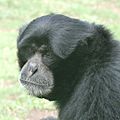Siamang facts for kids
Quick facts for kids Siamang |
|
|---|---|
 |
|
| Conservation status | |
| Scientific classification | |
| Kingdom: | |
| Phylum: | |
| Class: | |
| Order: | |
| Family: | |
| Genus: |
Symphalangus
Gloger, 1841
|
| Species: |
S. syndactylus
|
| Binomial name | |
| Symphalangus syndactylus (Raffles, 1821)
|
|
The Siamang (Symphalangus syndactylus) is a special type of gibbon. It has black fur and no tail. Siamangs live in the forests of Malaysia, Thailand, and Sumatra. They spend most of their lives in trees, which means they are arboreal animals.
Siamangs are the biggest of the "lesser apes." They can be twice as large as other gibbons. An adult Siamang can grow to about 1 meter (3 feet) tall. They can weigh up to 23 kilograms (50 pounds). The Siamang is the only species in its group, called Symphalangus.
Contents
What Makes Siamangs Special?
Siamangs are different from other gibbons in a few ways.
Fused Fingers
One unique thing about Siamangs is that two of their fingers on each hand are joined together. This is where their scientific name, "syndactylus," comes from. It means "joined fingers."
Throat Pouch
Siamangs also have a large "gular sac." This is a special throat pouch found in both male and female Siamangs. They can blow up this pouch to be as big as their head! This amazing pouch helps them make very loud calls or songs that can travel far through the forest.
Where Do Siamangs Live?
There might be two types of Siamangs. One lives in Sumatra and is called the Sumatran Siamang. The other lives in peninsular Malaysia and is called the Malaysian Siamang. Sometimes, the Malaysian ones are just seen as a group within the same species.
Siamangs are the only gibbons that live in the same areas as other gibbons. For example, they share their homes with the Agile Gibbon and the Lar Gibbon.
Siamang Life Cycle
Siamangs can live for a long time. In zoos or special care, they can live for over 30 years!
Protecting Siamangs
Siamangs face some big dangers in the wild. One problem is people sometimes try to buy and sell them as pets. This takes Siamangs away from their natural homes.
The biggest threat to Siamangs is that their forest homes are disappearing. Many forests in Malaysia and Sumatra are being cut down. This often happens to make space for Palm oil farms. When forests are destroyed, Siamangs lose their homes and food. Other animals, like the Sumatran Tiger, also suffer from this habitat loss.
Images for kids
See also
 In Spanish: Symphalangus syndactylus para niños
In Spanish: Symphalangus syndactylus para niños






